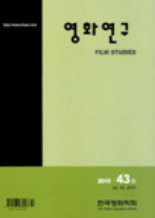- 영문명
- A Study on the Expansion of Cinematic Space: focused on Experimental film
- 발행기관
- 한국영화학회
- 저자명
- 장민용
- 간행물 정보
- 『영화연구』제43호, 333~354쪽, 전체 22쪽
- 주제분류
- 예술체육 > 예술일반
- 파일형태
- 발행일자
- 2010.03.31
5,440원
구매일시로부터 72시간 이내에 다운로드 가능합니다.
이 학술논문 정보는 (주)교보문고와 각 발행기관 사이에 저작물 이용 계약이 체결된 것으로, 교보문고를 통해 제공되고 있습니다.

국문 초록
영문 초록
The question that I wish to address in this study is how we can understand experimental films, given that they are highly subjective and non-narrative forms. Many experimental films lack an identifiable plot or theme. By using space as a mode of analysis, we are at the least able to give some order to the often confusing form and content. I selected some important experimental films to evaluate and tried to see how these works were able to expand their limits that cinema originally has in itself. First, I examined a aspect of expansion of filmic space through relationships between on-screen and off-screen space. Ken Jacobs's (1962), George Landow's (1965–66) show how the film maker utilized cinematic space. They are attempts to ask the relationship between on-screen space and off-screen space and expand the space of a frame while still remaining within its rectangular borders. Michael Snow's can be the archetypal film in this articulation of spatial distance. It moves beyond a pure analysis of the room's space to considerations of filmic space and the illusions that constitute it. examines space as, in part, a condition of depth and perspective. Another strategy of the avant-garde has been to use a flattened form of film space. In order to explore these features, I analyzed Stan Brakhage and Ed Emshwiller's works. One of the most exciting development in the creation of a unique cinematic space lies in the use of the rephotography process using optical printer. Bruce Baille's is a classical example of a film utilizing the refilming process to create a unique filmic space. The films that expanded the possibilities of film aesthetics tend to question and reconfigure the relationship between the camera and its subject. Any critical experimental films tried to explore how film apparatusfinite, twodimensional, enclosingconfronts space-infinite, threedimensional, continuous. Thus an examination of films whose subject is principally the depiction of space will be examination of how those films foreground the contradictory nature of their encounter with their subject. From this perspective, I studied some Avant-garde filmsWilliam Raban, (1973), Guy Sherwin, (2001),Bruce Baillie, (1966)과 (1995), Peter Gidal, (1973) that deals with depiction of place. Finally Filmic space in experimental film is a result of the dialectics of self and world from the perceptual distance. Beyond considerations of technique or composition, the critical nexus of Avant-garde film is how the artist spatializes the imagery of his or her inner world.
목차
1. 들어가는 말
2. 화면영역과 외화면 영역의 변증법
3. 실험영화의 공간과 지각의 거리
5. 맺는 말
해당간행물 수록 논문
- 영화 <밀양>과 소설 <벌레 이야기>의 서사 전략에 대한 비교 연구
- 유니버설 스튜디오와 디즈니랜드의 영화콘텐츠 활용연구
- 조선-만주 관광 문화영화와 ‘동아신질서’의 극장 경험
- 다큐멘터리와 아방가르드의 접점에서
- 가족을 대상으로 하는 사적 다큐멘터리에서 제기되는 윤리적 쟁점
- 구로사와 아끼라 영화의 마지막 결투 장면 연출 분석
- 한국영화산업 보호정책의 평가와 과제
- 해방기 영화운동과 조선영화협단
- 로베르 브레송과 다르덴 형제 영화의 유사성 연구
- 다큐멘터리란 무엇인가
- 문예영화 <안개>의 근대적 주체성 비판
- 이행적 친일영화(1940~1943)로서 <집 없는 천사>의 이중 의식에 대한 연구
- 중국의 한국영화 수용에 대한 연구
- 사단법인 한국영화학회 정관 외
- 영화적 공간의 확장에 대한 연구
참고문헌
관련논문
예술체육 > 예술일반분야 BEST
- 생성형 AI 도구와 디자이너의 협업 프로세스 개발 - 이미지를 통한 아이디어 확산에서 고해상도 렌더링까지
- 영화 [올드보이]와 소포클레스 「오이디푸스 왕」의 상동성 연구
- ‘일과 삶의 균형(Work-Life Balance)’ 척도 개발을 위한 연구
예술체육 > 예술일반분야 NEW
- Z세대 생활체육 동호인들의 SNS 중독 경향성과 불안정 성인애착이 완벽주의적 자기제시 및 우울에 미치는 영향
- 즐거움과 몰입을 통한 수익성 기대가 NFT 구매 의도에 미치는 매개효과 분석: UTAUT2와 합리적 무관심(RI)을 중심으로
- 생태체험이 청소년의 자연친밀감, 환경태도, 환경행동의도에 미치는 영향
최근 이용한 논문
교보eBook 첫 방문을 환영 합니다!

신규가입 혜택 지급이 완료 되었습니다.
바로 사용 가능한 교보e캐시 1,000원 (유효기간 7일)
지금 바로 교보eBook의 다양한 콘텐츠를 이용해 보세요!



